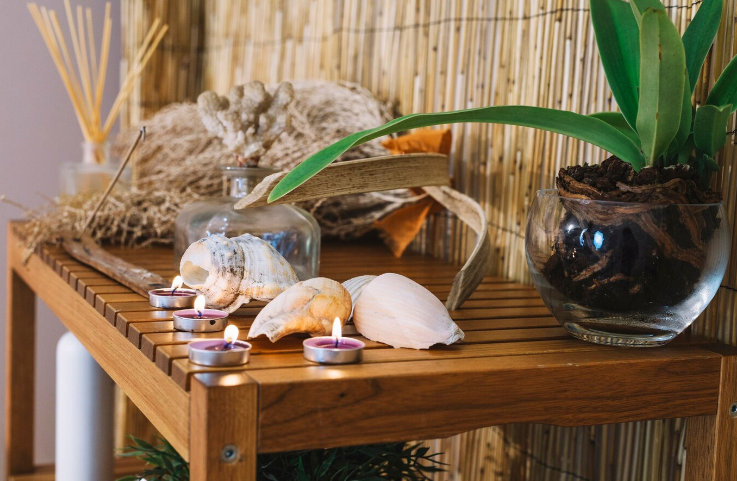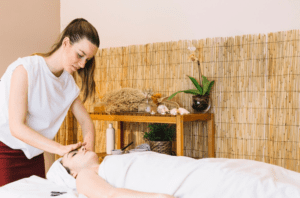Breast cancer treatment drains bodies and minds, causing lasting physical scars. One therapy is being studied as a potential aid. Breast massage is best for post-cancer recovery. This is because the breast is sensitive and has a medical history. Individuals must know how to approach breast massage safely. Especially after cancer therapy. This guide can help you navigate this delicate topic with care and confidence.
Understanding the Breast Massage Benefits Post-Cancer Treatment
Breast massage treatment post-cancer can bring several advantages, including:
Alleviating Pain and Discomfort
Radiation therapy, surgery, and other treatments often leave behind scar tissue and adhesions. These cause discomfort or limit movement. A gentle massage may help break down these adhesions. It can also improve tissue flexibility and reduce any associated pain.
Reducing Lymphedema
Lymphedema is swelling due to a buildup of lymphatic fluid. It is a common side effect after lymph node removal or radiation therapy. Manual lymphatic drainage (MLD) techniques such as lymphatic massage therapy (LMT) are used. Individuals can significantly reduce swelling while improving lymphatic circulation.
Enhancing Skin Elasticity and Health
While treatments may leave skin tight and less elastic. Massage therapy can help promote blood flow, speed healing, and restore skin suppleness.
Emotional Healing
Breast massage benefits can help survivors reconnect with their bodies and feel whole and well. It aids in treating breast massage for lumps.
Breast Massage Techniques
There are various breast massage techniques that may prove helpful. As part of post-cancer treatment, here are some of the more popular ones:
Manual Lymphatic Drainage (MLD): This gentle technique stimulates lymphatic system to reduce swelling. It involves light, rhythmic strokes to move lymph fluid toward lymph nodes.
Scar Tissue Massage: This technique, specifically targeting scar tissue, helps break down adhesions and increase tissue flexibility by applying gentle pressure.
Myofascial Release: It aims to release tension in the fascia. This is the connective tissue around the muscles. This breast massage is for breast pain in order to reduce tightness and increase mobility.
General Therapeutic Massage: This includes Swedish and deep tissue techniques. Explicitly tailored to avoid sensitive areas and promote overall relaxation and pain relief.
Why is Breast Massage After Cancer Treatment Necessary?
Massage is important after cancer treatments. This is especially true after surgeries like lumpectomy or mastectomy. It is key to the recovery and health of the affected areas. Here is why:
Breast massage helps the lymphatic system: This system is essential for clearing waste and fluid from the body. Following cancer treatments like surgery or radiation, lymphatic drainage may become impaired. Gentle massage may help reduce swelling (lymphedema) and improve lymph flow. This can boost immunity and speed healing.
Surgery and radiation: This can disrupt blood flow to the area they treat. So, massage helps increase the flow to tissues. This, in turn, brings oxygen and nutrients to cells for peak performance. Improved circulation may also assist with scar tissue reduction and regeneration processes.
Reduce Scar Tissue: Post-surgical scar tissue can create tightness, discomfort, and restricted movement. Massages use gentle kneading and stretching. They can break down scar tissue, making the area more pliable and less stiff. This improves the range of motion and comfort.
Enhances Emotional Well-Being: Cancer treatment can take its toll on emotional health, leading to anxiety, stress, and depression. Careful breast massage can comfort and relax. It can also improve body image. It encourages women to connect positively with their bodies again. It also helps them feel empowered over their recovery.
Aid in Post-Treatment: Regular breast massage lets women get used to their post-treatment breast tissue. They can feel for changes, like lumps, texture changes, or skin issues. They might show early signs of possible recurrence. Or they might show other problems that require medical evaluation. Regular massage therapy is for breast health. It helps women get used to their new tissue. It also helps them find any changes that arise after treatment. This can lead to timely medical evaluation and needed treatment.
Aid in Recovery: Massage helps women recovering from mastectomy or using prostheses. It can assist them in adapting to changes in breast shape and size. This supports rehab. It makes tissues more elastic and eases muscle tension near surgical sites.
Safety Recommendations
After cancer treatments, always prioritize safety during breast massage. Here are several vital points to bear in mind:
Consult with your healthcare provider: Before starting any new treatments. Always discuss them with an oncologist or healthcare provider. They can offer tailored advice. It fits your medical history and current condition. Avoid massaging areas while still getting medical treatment. Also, avoid areas where skin irritation has already occurred. Massaging them could worsen the irritation or damage the skin.
Be gentle: Tissues that have had radiation are very delicate. They should be massaged gently and non-invasively. This maintains patient comfort after treatment. Pay special attention when massaging scar tissue and areas affected by radiation.
Monitor for Infection: Be on the lookout for signs of infection, such as redness and warmth. Or increased pain near surgical sites if massage therapy has been performed recently. Stop using massage therapy if these symptoms appear during or after sessions. Contact a healthcare provider right away.
Steps for Conducting Breast Massage Safely at Home
With approval from your provider, you may safely massage your breasts at home. Here are some steps that will ensure its execution:
Prep Work: Choose a Relaxing Location: Find a comfortable place where you can unwind.
Lotion or Oil to Apply: Use a light breast massage oil or lotion. It helps your hands glide easily over your skin, allowing more of your massage technique to shine. Finally, the Technique Steps are Completed as Follows.
Warm Up: Begin by gently massaging the breast area. Use slow circular strokes around it, taking care to avoid surgical or radiation sites. Follow with light, sweeping strokes. Move from the outer edges toward the armpit and clavicle. This will stimulate lymphatic drainage and help move lymph.
Focus on Scar Tissue: If you have scar tissue, carefully massage around it, using small circular motions to loosen adhesions and break them down.
Duration and Frequency: To ensure best results and outcomes.
Keep sessions short: Limit each to 10-15 minutes to avoid overstimulation. Also, do them regularly at a level that’s comfortable for you and based on your healthcare provider’s recommendation.
Mistakes to Avoid Safe Breast Massage After Cancer Treatment
Breast massage is key in post-cancer recovery. It helps with circulation, reduces muscle tension, and boosts well-being. However, it must be performed carefully in order to avoid potential complications; here are key points for consideration:
1. Failing to Consult With Healthcare Professionals
Before starting any breast massage after cancer treatment, you must consult a healthcare provider. It’s absolutely essential. They will assess your unique circumstances, including any effects from surgeries or radiation, and make tailored recommendations on safe practices for you.
2. Applying Excessive Pressure
Avoid applying too much pressure during breast massage sessions. Instead, use gentle movements. They prevent tissue damage, bruising, and the worsening of lymphedema. Lymphedema is a common side effect of cancer treatment. It happens when lymph fluid builds up and causes swelling. This can happen if you use too much force.
3. Directly Massaging Over Surgical Scars or Radiated Areas
Massage should avoid sensitive areas like surgical scars or regions affected by radiation fibrosis. Instead, focus on massaging nearby areas to promote circulation and ease muscle tension.
4. Failing to Apply Proper Lubrication
Choose hypoallergenic, fragrance-free lubricants or moisturizers. They reduce friction and discomfort during massages. This is especially important for vulnerable, post-treatment skin.
5. Overlooking Signs of Discomfort or Complications
Be alert for changes during or following massage sessions, such as pain, increased swelling, or any unusual sensations. Report any such symptoms promptly to your provider. These symptoms could mean more serious conditions and need help.
6. Massage Sessions that Are Unpredictable
Having a regular massage schedule can maximize the many advantages of massage. These include better circulation and less tension. Just make sure that you adapt it according to how your body responds and any guidance from healthcare providers.
7. Neglecting Emotional and Psychological Considerations
Post-cancer treatment may present emotional challenges related to body image or touch sensitivity. To aid healing and ensure an inclusive recovery, make a supportive environment. Consider talking to a therapist about these aspects of recovery.
Conclusion
Breast massage can be an integral component of post-cancer treatment recovery. It provides both physical and emotional benefits. Learn various massage techniques and safety precautions. Ask healthcare professionals. They can help you add this therapy to your recovery. Remember, your body has gone through much; give it the tender care it deserves as you heal. Make sure to have open communication with your healthcare team. Also, watch your body signals. This is key to a full recovery.
FAQs
1: Would getting a breast massage after receiving treatment for breast cancer be safe? A: Definitely.
Receiving a breast massage post-breast cancer treatment can be safe. However, it’s wise to proceed with caution. Always consult an oncologist or healthcare provider before starting new treatments. They can offer personalized advice based on your medical history and current condition. Also, find a massage therapist who knows oncology techniques. They will use safe practices that fit your situation.
2: What are the advantages of breast massage following cancer treatment?
Breast massage after cancer treatment can offer many advantages, including:
Alleviating Pain and Discomfort: Helps break down scar tissue and improve tissue flexibility to ease discomfort, thereby decreasing pain.
Reduce Lymphedema: Specialists use techniques like manual lymphatic drainage (MLD). It reduces swelling and improves lymphatic circulation and lymphedema management.
Enhancing Skin Elasticity and Health: Enhance blood flow to promote healing and restore skin suppleness.
Emotional Healing: Help survivors reconnect with their bodies as part of emotional recovery.
3: Can breast massage pose any risks following cancer treatment?
While breast massage may offer many advantages, there may be potential downsides as well:
Sensitivity: After treatment, tissues can become very delicate; to ensure maximum comfort, it’s essential to use gentle techniques.
Risk of Infection: Massage areas that show signs of redness, and warmth. Or increased pain before massaging them, as these could indicate infection and further increase discomfort.
Worsening Conditions: Inappropriate techniques or excessive pressure may exacerbate existing conditions, causing discomfort. Its
To lower risks, always consult with a healthcare provider. Also, work with a certified oncology massage therapist.
4. Is breast massage safe after having undergone cancer treatments such as surgery or radiation therapy?
Yes, breast massage after cancer treatment can be safe and helpful. But, it should be done carefully under the guidance of an experienced therapist or healthcare provider. To make massage for lymphatic drainage, circulation, and scar tissue effective, they must be done in the right time frames and recovery stages. Always consult your healthcare team beforehand. They will tailor the massages to your situation and stage.
5. Is breast massage associated with increased risks for cancer recurrence or spread?
No evidence indicates that gentle breast massage increases the risk of cancer recurrence or spread. Massage boosts lymph flow and reduces lymphedema after lymph node removal for cancer treatment. It also eases lymph flow and decreases lymphedema symptoms. Avoid deep tissue massage. Also, avoid vigorous manipulation of breast tissue. This is after lymph node removal or radiation therapy. If you have any concerns about massage, please reach out directly to either your oncologist or certified massage therapist. They offer oncology massage and can give advice.
6. How often should I undergo breast massage post cancer treatment?
Discuss with your healthcare provider how often and hard it is to massage your breast. Its exact effect will depend on your recovery and any issues you’re having. Generally, self-massage or therapist massage should happen a few times each week or daily, as comfort and recommendations allow. Watching for breast tissue changes is key. Report them promptly to your medical team when they occur. This way, you can quickly get proper medical advice. Regular massage can promote healing, relieve discomfort, and enhance well-being during recovery. Always listen to your body by adjusting how often and how hard you get massages.





